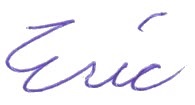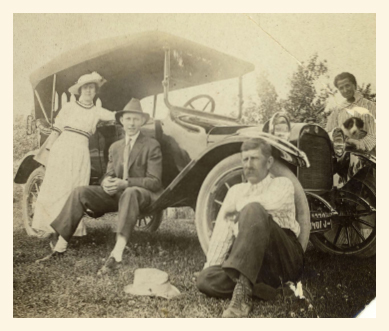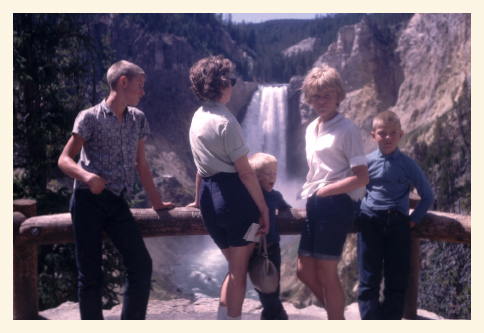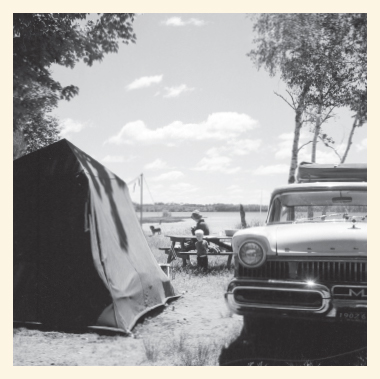By Eric Peterschmidt
Do you have a favorite family photo at home? Specifically, a vintage one? Perhaps of your grandparents? Or, your mother as a little girl? Or, your parents at your wedding? Most people do. I certainly do. In fact, my wife and I have the ones I just mentioned and many more old family photos hanging around our home. To me, they bring peace, comfort and joy when I look at them.
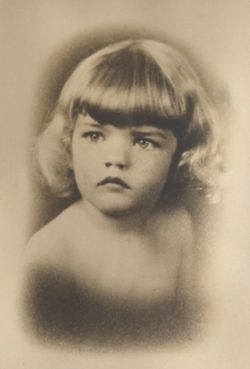
This is one of my favorites. It is my mom as a little girl. I inherited the downturned mouth! She was a peace-maker, and knowing that gives me strength to always try to be the same.
While it is true that my wife and I have many family items on display, we also have many more that are tucked away awaiting their moment to be brought out and shared. Please be aware that I am not like most people – at least in one way. You could classify me as a family history archivist, though some who know me might call me a family history “hoarder!” While I might be an exception, most people are in possession of at least a few treasured items that they have acquired over the years. For them, these items have trickled in from different sources – maybe as gifts from elders or as part of the passing of other family members. There may not be a lot of them, but they are there.
Then there’s a sound…
What happens if there is a knock on your door, and suddenly you are presented with boxes of old family photos from one of your elders who had just passed? For an archivist like me, that would be a gift! But for you and perhaps many people, you might feel quite the opposite.
I was recently talking to a friend. He and his wife are empty nesters. He felt it was a good time for him to figure out what to do with the photos they had taken of their life with their kids over the years. He is not an archivist, but does value the photos they took and wanted to get them consolidated, organized, and into a safe place where they could be viewed and treasured. For him, this was a nice leisurely project, and he enjoyed chipping away at it.
But then things changed: his mother passed. He and his family, like all families in that situation, grieved the loss, and then found the strength to move on. Sometime later, his sister visited and dropped off 3 tubs of old family photos! These were photos that both his mother and father had acquired. As he started going through them, he was amazed, yet overwhelmed at the same time.
Amazed, because the old family photos were indeed of his parents’ families – going back a couple generations, including childhood friends and neighbors.
Overwhelmed because he did not know what to do with them.
He did know one thing: “I can’t throw them away – even though I don’t know who a lot of the people are.” His project was no longer just about his wife and kids. This archive, which had just fallen on his lap, was much more significant – going back generations. It was the best record he had seen of his family’s story. With this came a new feeling and source of anxiety – of stewardship – as this record was now his responsibility to figure out how best to care for and protect. What was he going to do? Bye-bye leisurely project and hello stress and anxiety!
This is not a unique event. Baby Boomers have been going through this for several decades already.
In fact, it happened to me.
My siblings and I lost our mom and dad in 1987 and 1988, respectively. With their passing came the dividing up of their belongings, which included a large number of photos my dad had either inherited or taken himself. My siblings and I all understood the value of these and would have never thrown them away, because of my dad’s slide shows we grew up with. (Watch for a future post about the influence of the Kodak Carousel Projector to understand why.) But what do we do? Especially for us at that moment in time. We were all in young families – some with kids, and lots on our plates. And the photos were just one of hundreds of our parent’s things that we had to make decisions about.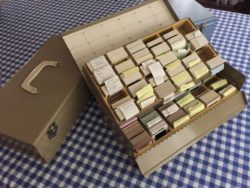
So, just like their other belongings, we started to divide the old family photos up amongst ourselves. Fortunately, we quickly realized that breaking this legacy into fragments was a bad idea. Why? Well, fragments will get smaller and smaller in years to come, as they are divided again and again with our children (keep in mind this was before digitization was available). Over time, fragments lose valuable context to the other photos they were with and potentially become orphaned and meaningless. Who is that? Where was it taken? What is going on? When the names of the people and subjects of the images are lost, these photos are destined for the landfill. That was something that I was deathly afraid of.
So, I suggested we keep the old family photos in a set, and I offered to hold on to them. While doing so, I would figure out how best to share with everyone, yet not lose the context and inherent value. That, for many reasons, turned out to be a great decision. Over 30 years later we still have all of those photos in a set (20,000 and still counting).
You might ask “why start a business? With digitization, can’t you just scan the photos and give everyone a copy?” We did that. We have scanned in almost all of my dad’s photos. But what do you do with the now digital photos? I saw how many (including myself) scanned images in and gave copies of the digital files to their family, usually on CDRom, USB thumbdrive or via email. But what happened? The many copies of those files ended up being put in drawers or dropped into a computer folders and basically “lost”. All we did was solve one problem (a box of photos) by creating another (many digital boxes of photos). I knew there had to be something better.
I was not looking to start a business, but instead looking to solve a problem. And, because no solution existed to help us do what we felt was needed to capture, share, and preserve the images, I formed a company and built the solution we needed: TightKnit.com – a solution that creates virtual kitchen tables for families to privately share and document the memories and stories these photos trigger.
Since that time, I learned early a number of things that became foundational to what has become the TightKnit solution:
1. Photos are magic.
They automatically trigger memories for those who were there – without breaking a sweat! It is like time traveling, and made even more amazing when you do it with other family who were there.
2. It is not the photo that we are preserving – it is the STORY behind the photo.
Without that story – the “who/what/where/why/when” of what was captured at the moment of exposure – that photo is likely to have little meaning, other than perhaps artistic value. So, simple “photo sharing” did not cut it. There had to be a way to include the stories.
3. Memories and stories have always been oral history, and oral history erodes with time.
We needed to permanently connect the stories to the photos so that they will never be split up. In achieving that, we have not only preserved the stories that would otherwise go to the grave with the people who knew them best, but we have also provided future generations the context they need for the photos they inherit. They won’t inherit a box of photos. They will inherit a lasting legacy.
4. It is all about “WE”, not all about “ME”
Memories and stories are good when you recall them yourself. But, they are better when others who were there join you to share what they recall. It is human nature. People remember things differently, experience things differently, have different interests and emotions. Remember your aunts and uncles reminiscing about life back in the day? The bantering they did back and forth? That bantering has gone on for the history of mankind. It is that collective story that we need to capture. There are other benefits of working together too:
Everybody has something, nobody has everything. When you lose someone you love, things get disseminated across surviving family members. Not just photos, but videos, heirloom items, letters, and other family artifacts. Wouldn’t you like to have a way to re-connect those “orphaned” items with the rest of your extended family, creating a much richer library to experience and build on? For example, combining all of the photos everyone has of your family living on the farm during the Depression.
Everybody knows something, but nobody knows everything. While you may have photos that you 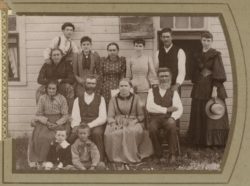 don’t know who the people are, other people who are alive today may. A case in point. I have 2 photo albums that my dad had inherited. They are from the late 1800s, and are of my grandmother’s parent’s family. Nobody in my family knows who the people are, and we lost track of any other offspring from that generation on Grandma’s side of the family. Through a DNA test, a cousin of mine was connected with a distant cousin from this family who is a genealogist who has done research of this family going back generations. What she does not have are photographs of the family. Her knowledge of the family combined with my library of photos was a “marriage made in heaven.” Together, we’re breathing life into these old photos as she helps me put names to the people and shares what she has learned about their stories. Incredible!
don’t know who the people are, other people who are alive today may. A case in point. I have 2 photo albums that my dad had inherited. They are from the late 1800s, and are of my grandmother’s parent’s family. Nobody in my family knows who the people are, and we lost track of any other offspring from that generation on Grandma’s side of the family. Through a DNA test, a cousin of mine was connected with a distant cousin from this family who is a genealogist who has done research of this family going back generations. What she does not have are photographs of the family. Her knowledge of the family combined with my library of photos was a “marriage made in heaven.” Together, we’re breathing life into these old photos as she helps me put names to the people and shares what she has learned about their stories. Incredible!
5. Tomorrow’s history is happening today.
This is not just about the past, but about the future. In all of human history, there has never been an opportunity to capture life’s experiences like you have today. With that comes the risk of losing so much if you do nothing. So, are you set up for the future? To start with, ask yourself “Where are the photos that I took last year? How about 15 years ago?”
Like most people, your photos are probably scattered across a bunch of phones, cameras, cloud storage services, photo sharing sites and boxes in closets. That is not a solution – it is not sustainable. How will you and others in your family, find specific photos tomorrow? Maybe you are wondering if you need to keep them all. Probably not.
However, while you can argue that you don’t need to capture the amazing Philly cheese steak sandwich you just had for lunch, the truth is, as Dr. Suess said; “Sometimes you will never know the value of a moment, until it becomes a memory”. Wouldn’t it be nice if the photos you were taking today could automatically be dropped into an organized structure so that they can easily be found and enjoyed tomorrow?
6. Remember, most social networks are not private.
How much of your family’s story should be for your family’s eyes only? You should not have to pore through layers of confusing privacy settings to protect yourself and your family. And there should be no mining of your information for 3rd parties to capitalize on. Maybe you see it differently, but I want to know who sees my stuff, and my family interests are not for sale to the highest bidder.
7. Create an immersive experience to pull your family in
Have you tried looking for that photo from a vacation you took in 2004? Not easy. And while finding things is important, the right solution is more than that. The opportunity here is to create a place that engages your family and allows them to “travel” along story, interest or conversation threads. To discover and dive deeper as their interests dictate. Threads such as events (your parents wedding), people (your great grandmother), objects (the gold nugget tie pin from your great great uncle) or locations (your grandparent’s farm). The bottom line is that a digital shoebox does not cut it. Your family stories deserve something better.
These guiding principles did not just come to me at one moment. Instead, it was over many years as I researched this. My professional career, as it turned out, provided me with some of the insight to solve this. I worked for a large technology company, with much of my time spent on interactive media. From the dawn of this technology in the late 1980s, I learned how a user’s experience on a computer, when properly designed, can solve problems. Combine that with automation – that is, to minimize or eliminate the need for the user to do unnecessary tasks. When done correctly, something of great value is created.
OK, so I know I might be an exception. And fortunately, you don’t need to create a new business just to figure out the best way to tackle boxes of photos if they fall on your lap. But what about you? What is your situation? Have you had family photos fall in your lap? If so, regardless of what technology solution you may choose to eventually try, I do have some suggestions on what to do if this should happen to you:
1. First of all, stay cool! Attitude is everything. While the box of old family photos may fluster you when it comes in, know that it may be a gem of an opportunity. Remember, that it could have just as easily been thrown out, with all of that history lost forever. So, be excited in a good way – even if you don’t know yet know what to do about it.
2. Keep the old family photos together! Resist dividing them up with other people, unless they are partnering with you to digitize them. This is important, as the value of the fragments will never equate to the value of the set as a whole.
3. Visualize what it could be like later. Imagine you, your siblings, parents, children, grandchildren browsing through a timeline of their family history, engaging in conversations around a “virtual kitchen table”. Allowing all of you to connect and re-connect with family. Open ended, not locked down like a printed book. A living, breathing history created by the family – for the family, for generations to come.
4. Find collaborators to help you. You don’t need to do this on your own. How do you get others involved? Look for interested parties to help.
5. Create a plan of attack. Work with your “team” if you have been able to get one together. For a high-level process that can get you started, download our free tool which lays out a 4 step process to transform a box of old family photos into a lasting legacy.
There may come a day (if it hasn’t come already) when the family archive of all those old family photos will land in your lap. How you respond to that challenge is something that will carry on for generations.
